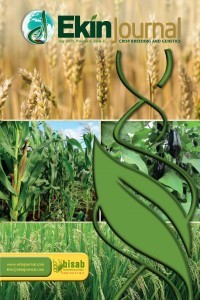Recent Developments in Triticale Breeding Research and Production - An Overview
Recent Developments in Triticale Breeding Research and Production - An Overview
This paper reflects an overview and collates possibly new information about current triticale status in Poland and elsewhere. There will be considerable production, breeding research, biology, and agronomy of triticale. Considerable improvements were made in modern triticale cultivars with respect to agronomic performance, resistance to biotic and abiotic stresses and nutritional quality, in particular for human consumption and wider adoption as a viable commercial crop. In the past decades, new breeding tools and enabling technologies (doubled haploid, marker assisted selection, genomics selection, transgenic, functional genomics, and targeted genome editing) have been refined or developed anew and are successfully exploited in triticale improvement. Through, the integration of these tools and technologies with conventional plant breeding approaches, triticale biological potential has been enhanced to make this small grain species an economically successful crop.
Keywords:
Triticale, breeding, biotechnology, resistance, somaclonal androgenic variation,
___
- Ahmed K. Z., and Allam H. Z., (2003). Response of intergeneric hybrids of Egyptian wheat with ryeto in vitro techniques. African Crop Science Conference Proceedings, Vol. 6; 98-102.
- Arseniuk E., (1996). Triticale diseases - a review. Triticale: Today and Tomorrow. Developments in Plant Breeding 5: 499-525.
- Arseniuk E., (2015). Triticale abiotic stresses - an overview. [In:] Triticale Book, Agri-Food Canada Part II, ISBN 978-3-319-22550-0: 69-82.
- Arseniuk E., and Góral T., (2015). Triticale biotic stresses - known and novel foes. [In:] Triticale Book, Agri-Food Canada Part II, ISBN 978-3- 319-22550-0: 83-110.
- Arseniuk E., and Walczewski J., (2014). Effect of dihaploid technology on resistance of winter wheat and winter triticale to Stagonospora nodorum blotch. In: Behl RK,
- Arseniuk E (eds) Proceedings of the international conference on biotechnology and plant breeding perspectives- towards food security and sustainability, 10- 12 Sept 2012, IHAR-PIB Radzikow, Poland. Agrobios (International), New Delhi, pp 32-329.
- Blum A., (2014). The abiotic stress response and adaptation of triticale – a review. Cereal Research Communications 42(3), pp. 359–375 (2014), DOI: 10.1556/CRC.42.2014.3.1.
- FOA Stat., (2016). www.fao.org/statistics/en/
- Furman B., (2016). Triticale: Overview. In C. W. Wrigley, H. Corke, & K. Seetharaman (Eds.), Encyclopedia of food grains (2nd ed.). Oxford, UK: Elsevier Science & Technology.
- https:// search.credoreference.com/content/topic/triticale. embed.
- Góral H., Tyrka M., and Spis L., (2005). Assessing genetic variation to predict the breeding value of winter triticale cultivars and lines. J. Appl. Genet. 46(2), 2005, pp. 125-131.
- Kang H., Wang H., Huang J., Wang Y., Li D., Diao C., etal., (2016). Divergent development of hexaploid triticale by a wheat - rye - Psathyrostachys huashanic atrigeneric hybrid method. PLoS ONE 11(5): e0155667. doi:10.1371/ journal. pone.0155667. pages 1-14.
- Ma X. F., and Gustafson J. P., (2006). Timing and rate of genome variation in triticale following allopolyploidization. Genome 49: 950-958.
- Mergoum M., and Gómez-Macpherson H., (2004). Triticale improvement and production. FAO Plant Production and Protection Paper 179: 172 pp.
- Mergoum M., Singh P. K., Pena R. J., Lozano-del Rio A. J., Cooper K. V., Salmon D. F., and Gomez Macpherson H., (2009). Triticale: A “New” Crop with Old Challenges. Chapter from book Cereals (pp.267-287).
- Niedziela A., Orłowska R., Machczyńska J., and Bednarek P. T., (2016). The genetic diversity of triticale genotypes involved in Polish breeding programs. SpringerPlus 5(355):1-7. Pilch J., (2001). Crossability effects of spring wheat (Triticum durum Desf.) with rye (Secale cereale L.) genotypes. Plant Breeding and Seed Science 45: 33-43.
- Hakeem K. R., Tombuloğlu H., Tombuloğlu G., (2016). Plant Omics Trends and Applications. Springer, Switzerland. https://www.springer.com/gp/ book/9783319317014
- Reszka E., Song Q., Arseniuk E., and Cregan P. B., (2007). The QTL Controlling Partial Resistance to Stagonospora nodorum Blotch Disease in Winter Triticale Bogo. Plant Pathology Bulletin 16:161-167.
- Wilson A. S., (1876). Wheat and rye hybrids. Edinb Bat Sac Trans. 12: 286–288.
- Zimny J., and Loerz H., (1996). Biotechnology for basic studies and breeding of triticale. In: Triticale today and tomorrow. Kluwer Academic Publishers, (Eds. H. Guedes-Pinto, N. Darvey, V. P. Carnide), p. 327-337.
- ISSN: 2149-1275
- Yayın Aralığı: Yılda 2 Sayı
- Başlangıç: 2015
- Yayıncı: Bitki Islahçıları Alt Birliği
Sayıdaki Diğer Makaleler
Recent Developments in Triticale Breeding Research and Production - An Overview
Halit KARAGOZ, Umran KUCUKOZDEMIR, Berrin DUMLU, Zeki YALCIN
Meteroglyph Analysis of Cowpea (Vigna unguiculata L.Walp) Elite Genotypes
Rajesh Kumar ARYA, Ravish PANCHTA, Nguyen Nagoc VU, Surender Kumar PAHUJA
Sudhir Kumar SETHI, Krishnendu GUIN, Rajesh Kumar ARYA
Tea (Camellia sinensis) Cultivation and Breeding in Turkey: Past and Present Status
Fatih SEYIS, Emine YURTERI, Aysel OZCAN
Performance of Wheat Genotypes for Grain Yield and its Attributes under Irrigation with Saline Water
Rishi Kumar BEHL, Babita KHOSLA, Pravin Kumar SHARMA, Mohammad AHATSHAM, Vikash VIKASH, Pratima PRATIMA, Vijay DAHIYA, Om Prakash BISHNOI
